Sickle Cell Disease by Jing Xia
This illustration highlights sickle cell disease’s painful impact, healthcare inequality, and the urgent need for awareness, empathy, and improved treatment.
View moreExplore how science students and illustrators joined forces to creatively reimagine a more inclusive biosciences curriculum—through cartoons, animation, and powerful visual storytelling.
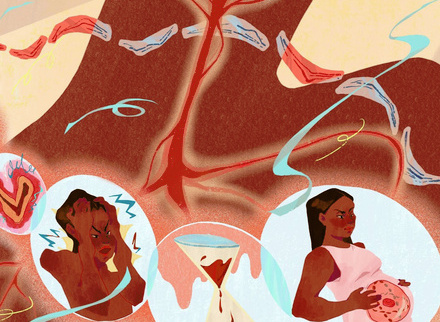
This illustration highlights sickle cell disease’s painful impact, healthcare inequality, and the urgent need for awareness, empathy, and improved treatment.
View more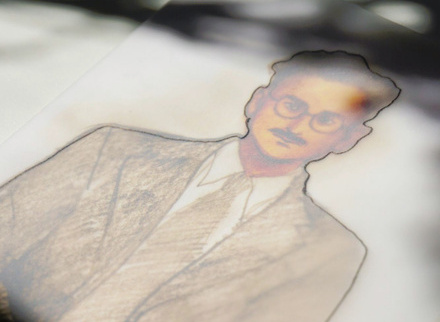
This series honours Pakistan's first Nobel laureate in science. It explores his journey and legacy through blurred portraits and silhouettes, questioning who is visible in science.
View more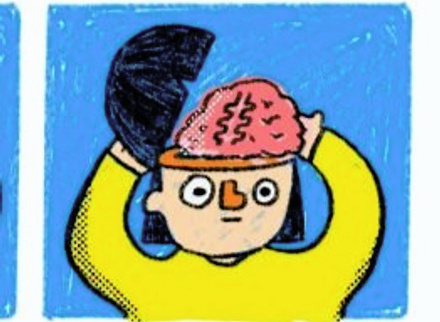
This illustrated satirical comic strip highlights neurodivergent students’ struggles with rigid academic systems, exposing the irony and unreasonableness of proving their needs.
View more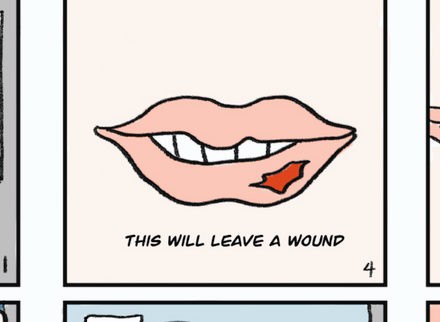
This illustrated comic links lip healing to uterine repair during menstruation, highlighting the female body's unseen efforts and the need for greater awareness of gynaecological health.
View more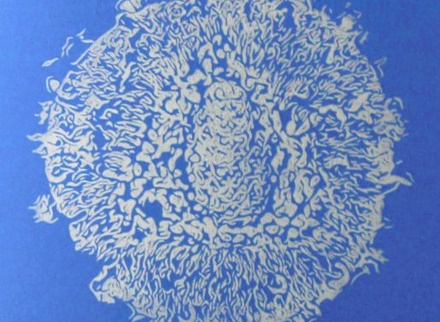
Using letterpress printing to blend art and medicine, this book highlights the beauty and horror of STIs while advocating for marginalized groups and challenging societal stigmas.
View more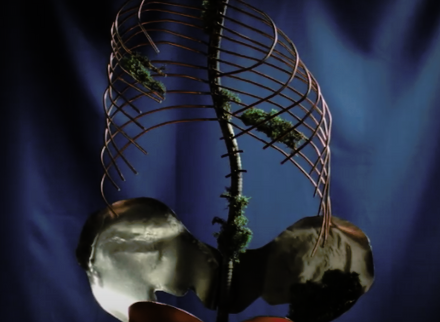
This stop-motion animation transforms a kyphoscoliosis-afflicted skeleton into a tranquil tree, using vivid colours, organic forms, and natural soundscapes to reveal the beauty of a curved spine.
View moreIn May 2024, a series of workshop sessions was initatied by Drs Nick Freestone, Francesca Arrigoni and Stephanie Black. The aim was to facilitate conversation and collaboration between students from Kingston University’s BSc Pharmaceutical Science degree and MA Illustration programme.
Facilitated by artist Ravista Mehra, the workshops explored the lived experiences of the culturally and ethnically diverse Pharmaceutical Science students. These discussions centred around personal life experiences with science, health, university life and society, framed through an innovative and creative artistic lens.
In the inital stages of the project, the students had been tasked with diversifying the biosciences and making profile postcards of under-represented scientists. Through primary and secondary research, the illustrators identified various barriers to entry to the professional field, which involved asking challenging questions of their own institution, and the format they’d been tasked with using. Therefore they redefined the brief and the projects resulting from this were more aligned with the principles of decolonisation.
As a result of the rich and animated conversations during the workshops, the MA Illustration students began to visually interpret and represent the stories they heard. Their work ranged widely in style and content, inlcuding: a cartoon infographic about the challenges faced by neurodiverse students in higher education, artwork on sickle cell disease, and a stop-motion animation of talking pills discussing the under-representation of women and people of colour in the curriculum. Another piece portrays the life of Pakistan’s first Nobel Prize winner.
In a separate but aligned initiative, Dr Arrigoni was inspired by a student visit she organised to the Hunterian Museum which houses artefacts relating to the history of surgery and anatomical studies. She responded by producing a series of images reflecting her thoughts and feelings arising from the visit.
These outputs mark what is hoped to be the beginning of an ongoing series. The goal is for each student to find their place in the curriculum and feel like a valued part of a living, breathing learning community.
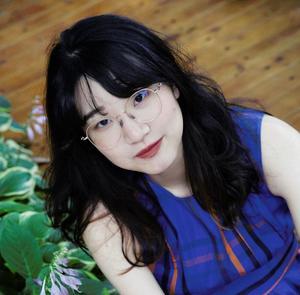
I'm Jing Xia, a graduate of the Illustration MA program at Kingston University. I specialise in series illustrations and picture books, and I enjoy working with hand-drawn techniques and watercolor. My style is warm and gentle, often focusing on themes such as feminism and utopia. I'm passionate about capturing unnoticed details in everyday life and exploring the diverse ways women live across different societies.
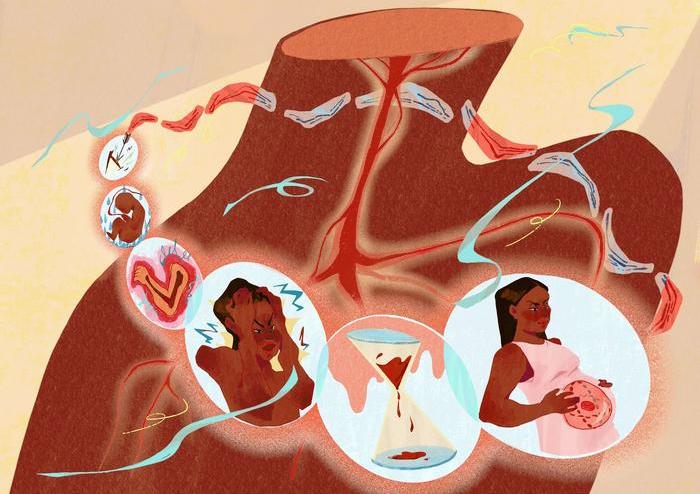
The inspiration for my illustration comes from sickle cell disease. I hope that those who see this work will gain a deeper understanding of this disease and the discomfort it causes.
Through my discussions with my partner, I learned about her frustration with the current healthcare system, and the prejudice and delayed medical treatment resulting from a lack of awareness about this disease.
Sickle cell disease, common among people of color, causes round cells to become elongated and sharp, leading to blockages in blood vessels. It increases infection risk, headaches, anemia, and poses higher risks during significant blood loss situations like pregnancy. Despite being a lifelong condition, it lacks effective treatment and understanding.
Sickle Cell Disease, Health Inequality, Racial Bias, Medical Prejudice, Patient Voices
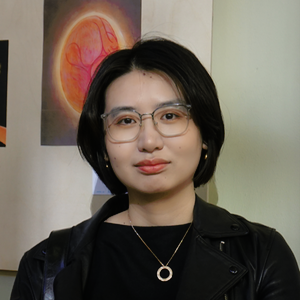
Nuode LI is an interdisciplinary visual artist, illustrator, and printmaker whose work explores themes of emotion, memory, language, individual experience, and the natural world. She holds an MA in Illustration from Kingston University, where she developed her passion for combining traditional and digital media, and an MA in Visual Culture Studies from the Chinese University of Hong Kong, which provided a strong foundation in theoretical frameworks.
Her artistic practice transcends the limitations of a single medium, combining illustration, printmaking, and ceramics to explore materiality and craftsmanship. Drawing inspiration from literature and daily life, Nuode captures delicate emotions and visual elements that show the lives of ordinary people amidst rapid societal and global changes, resisting grand narratives and emphasizing individual experiences in contemporary society.
Nuode’s work has been exhibited in London, Cambridge, and Liverpool, and received the Finalist in the Hiii Illustration 2022, Books Merit Award in the iJungle Illustration Awards 2024, and Publishing Longlist in the World Illustration Awards 2025.

Abdus Salam was born in Jhang, a small town in what is now Pakistan, in 1926. His father was an official in the Department of Education in a poor farming district
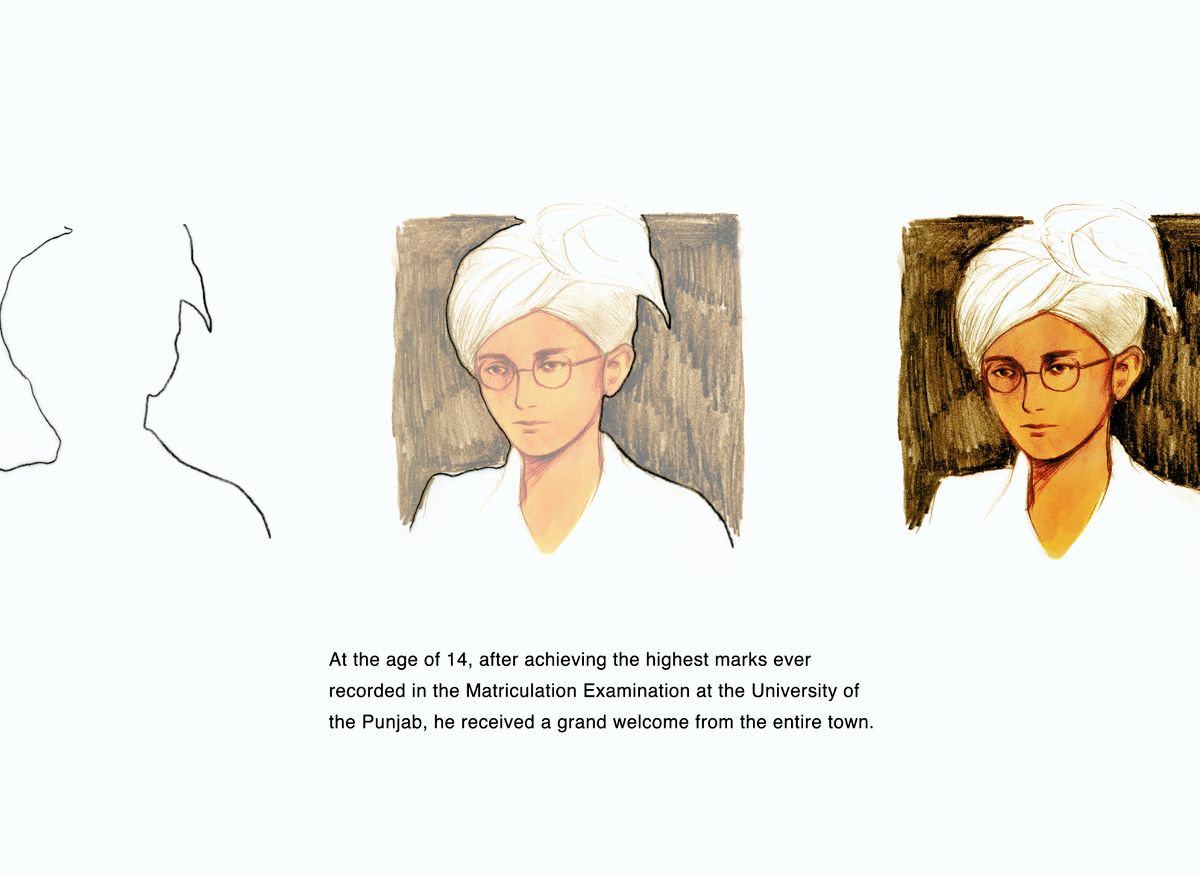
At the age of 14, after achieving the highest marks ever recorded in the Matriculation Examination at the University of the Punjab, he received a grand welcome from the entire town.
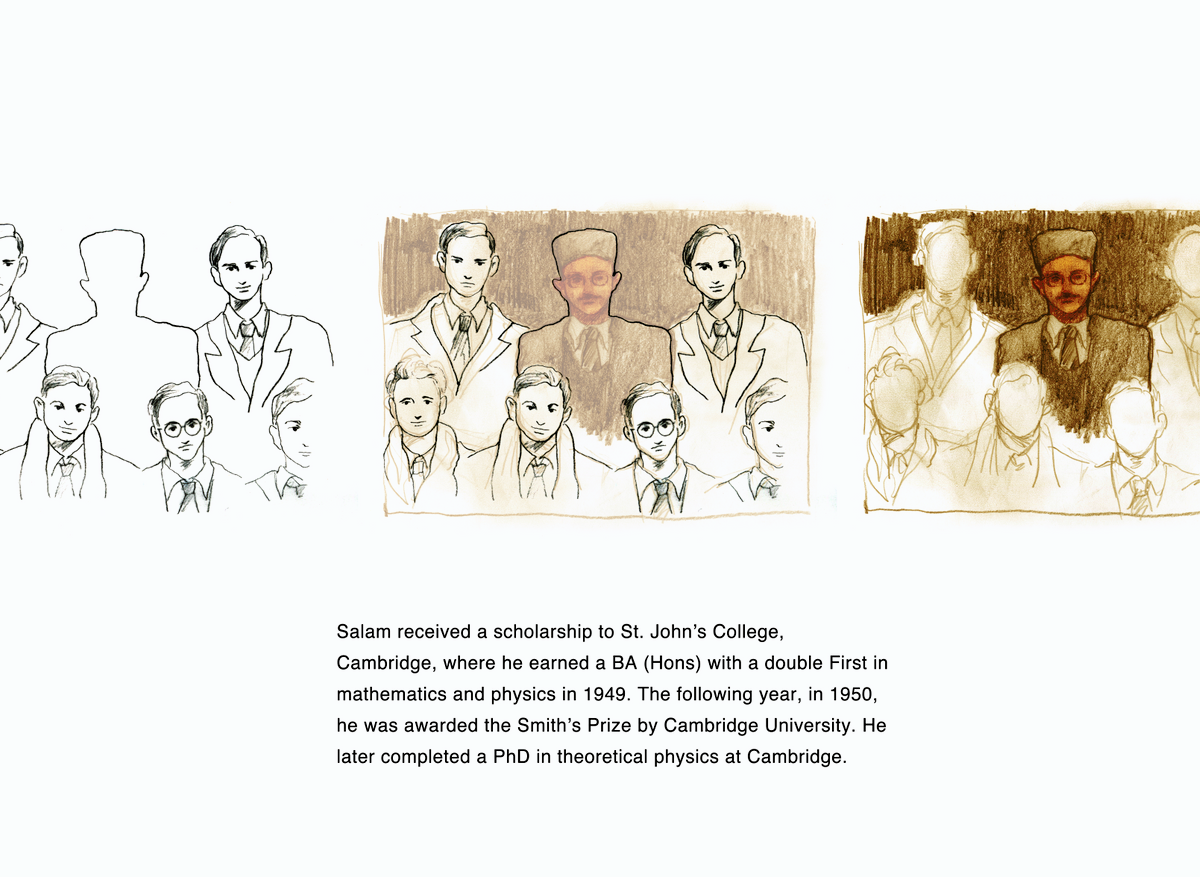
Salam was awarded a scholarship to St. John's College, Cambridge, where he took a BA (hons) with a double First in mathematics and physics in 1949. The following year, in 1950, he was awarded the Smith's Prize by the University of Cambridge. He later completed a PhD in theoretical physics at Cambridge.
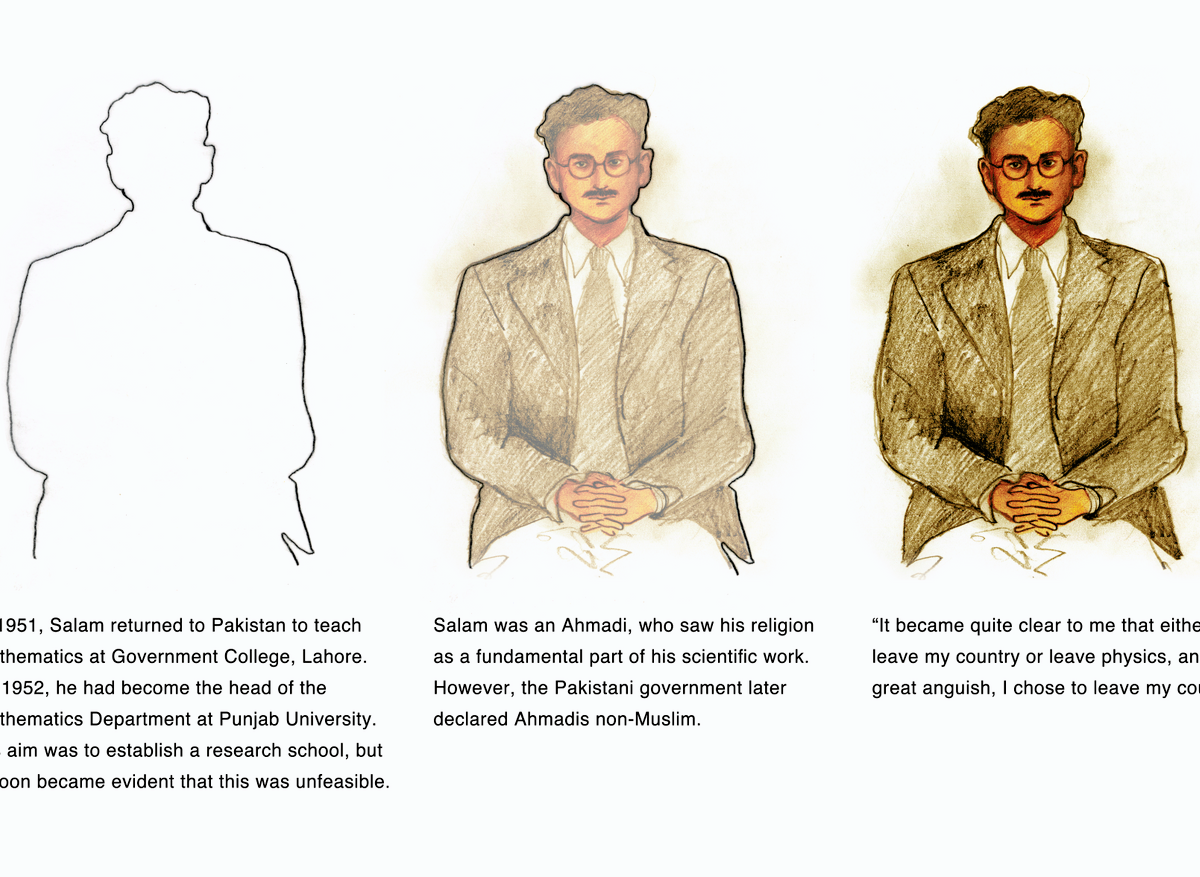
In 1951, Salam returned to Pakistan to teach mathematics at Government College, Lahore. In 1952, he became the head of the Mathematics Department at Punjab University. His aim was to establish a research school, but it soon became evident that this was unfeasible. Salam was an Ahmadi, who saw his religion as a fundamental part of his scientific work. However, the Pakistani government later declared Ahmadis non-Muslim.
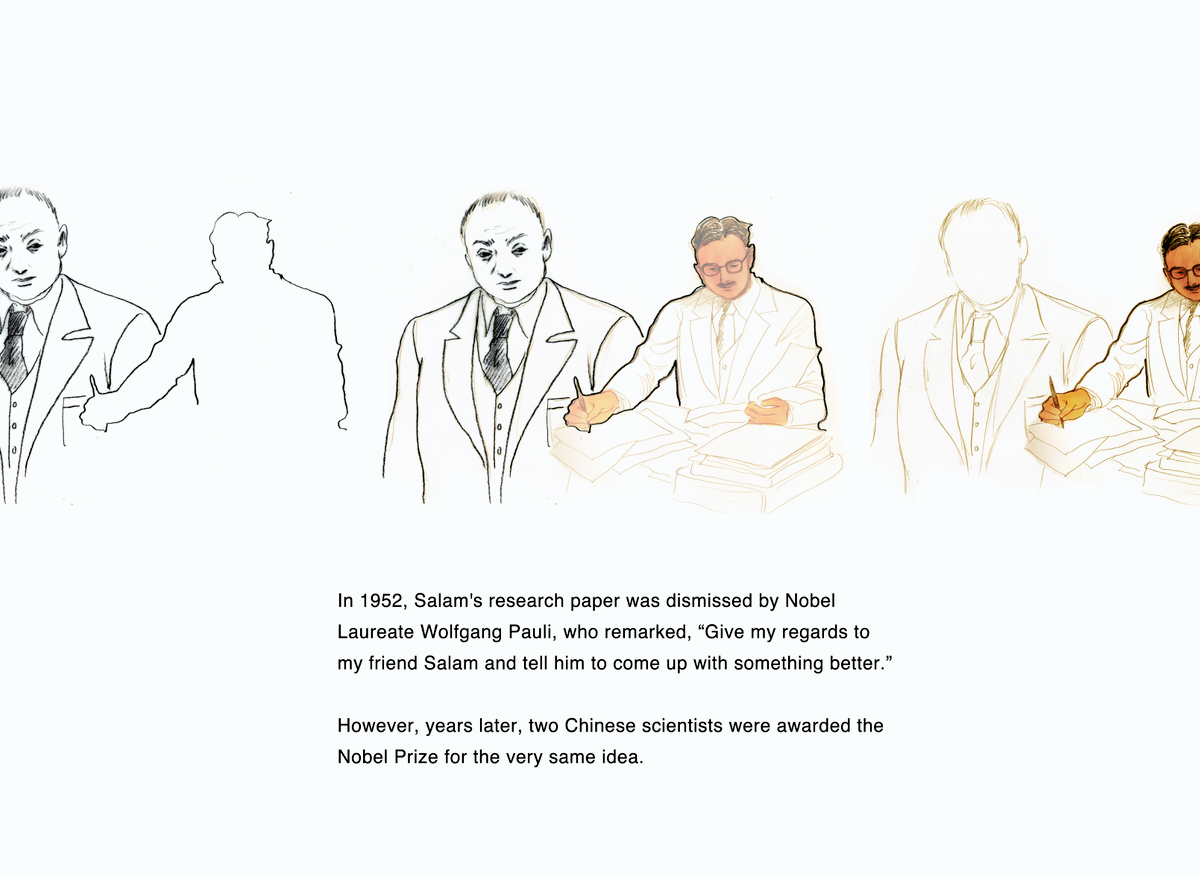
In 1952, Salam's research paper was dismissed by Nobel Laureate, Wolfgang Pauli, who remarked "Give my regards to my friend Salam and tell him to come up with something better." However, years later, two Chinese scientists were awarded the Nobel Prize for the very same ideas.
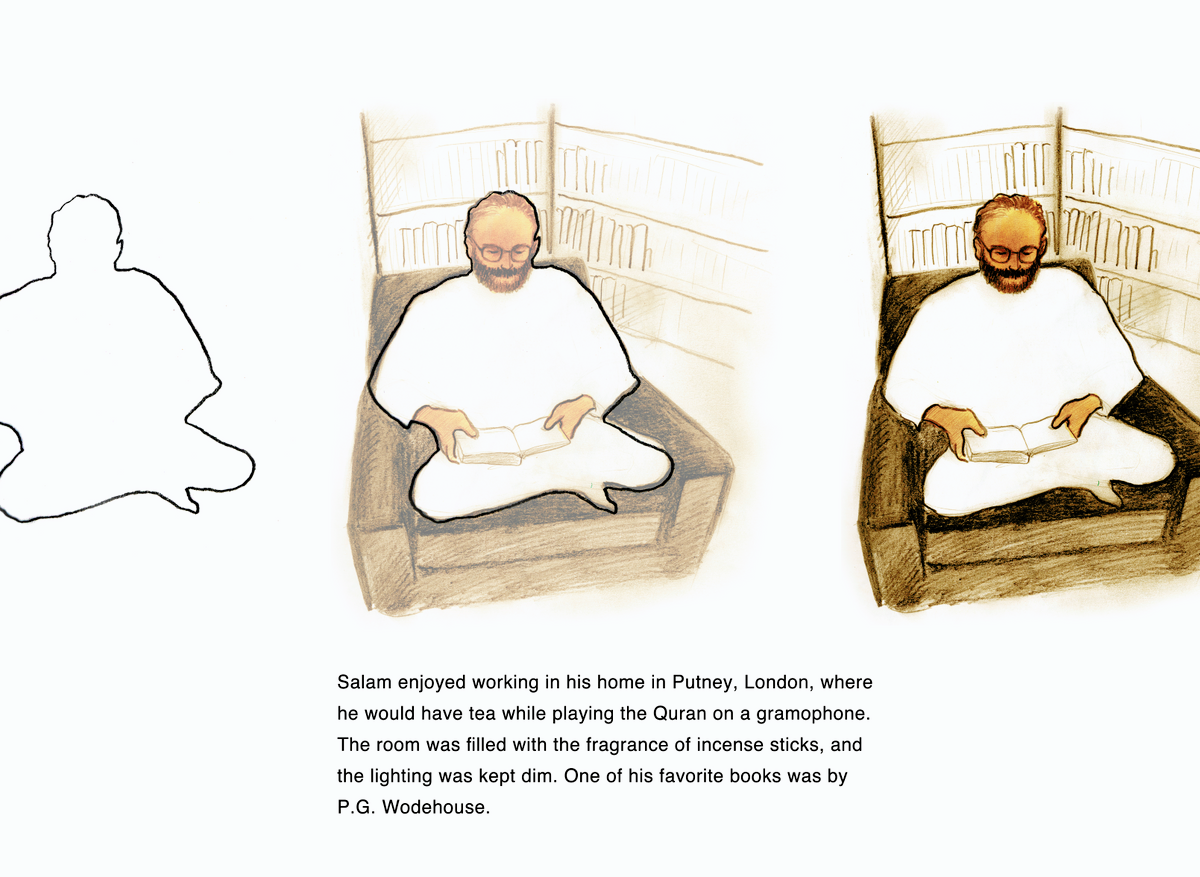
Salam enjoyed working in his home in Putney, London, where he would have tea while playing the Quran on a gramophone. The room was filled with the fragrance of incense sticks, and the lighting was kept dim. One of his favourite books was by P.G. Wodehouse.
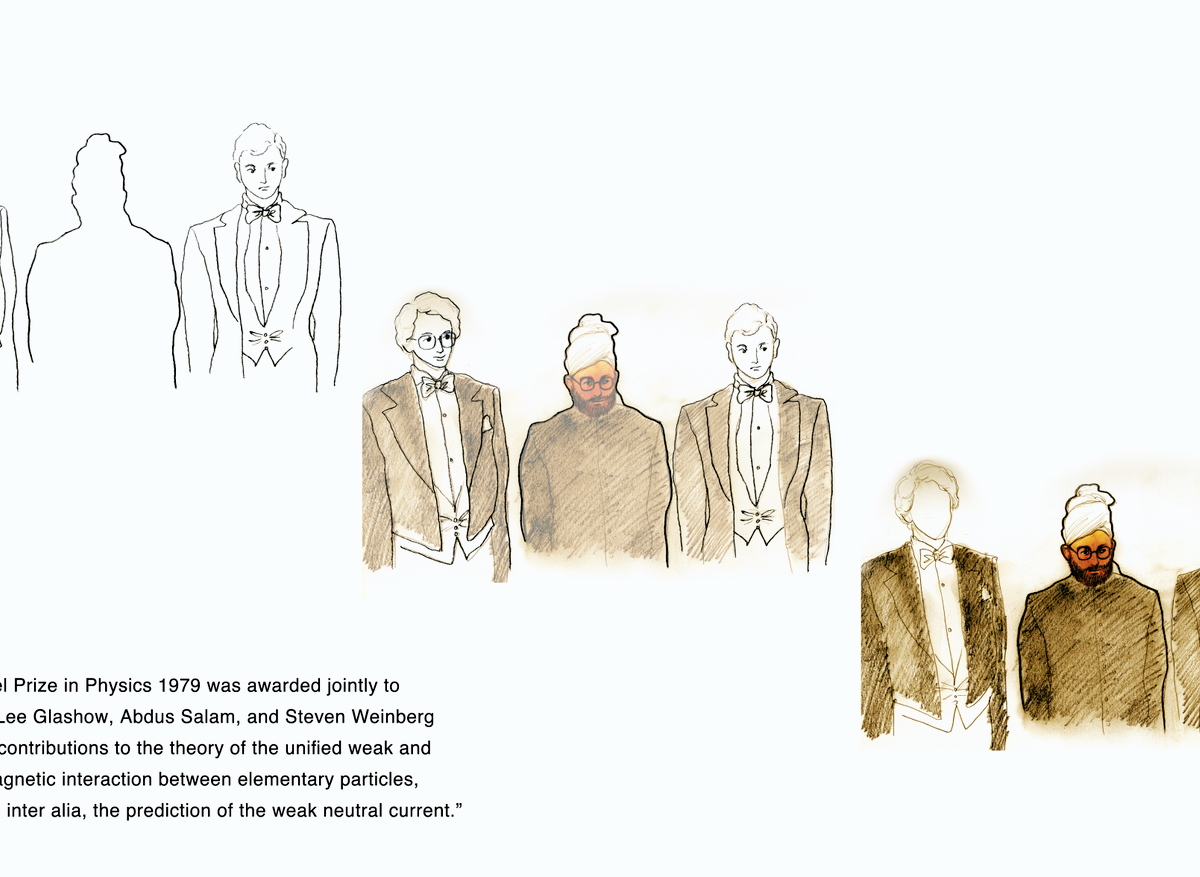
The Nobel Prize in Physics 1979 was awarded jointly to Sheldon Lee Glashow, Abdus Salam, and Steven Weinberg “for their contributions to the theory of the unified weak and electromagnetic interaction between elementary particles, including inter alia, the predication of the weak neutral current”.
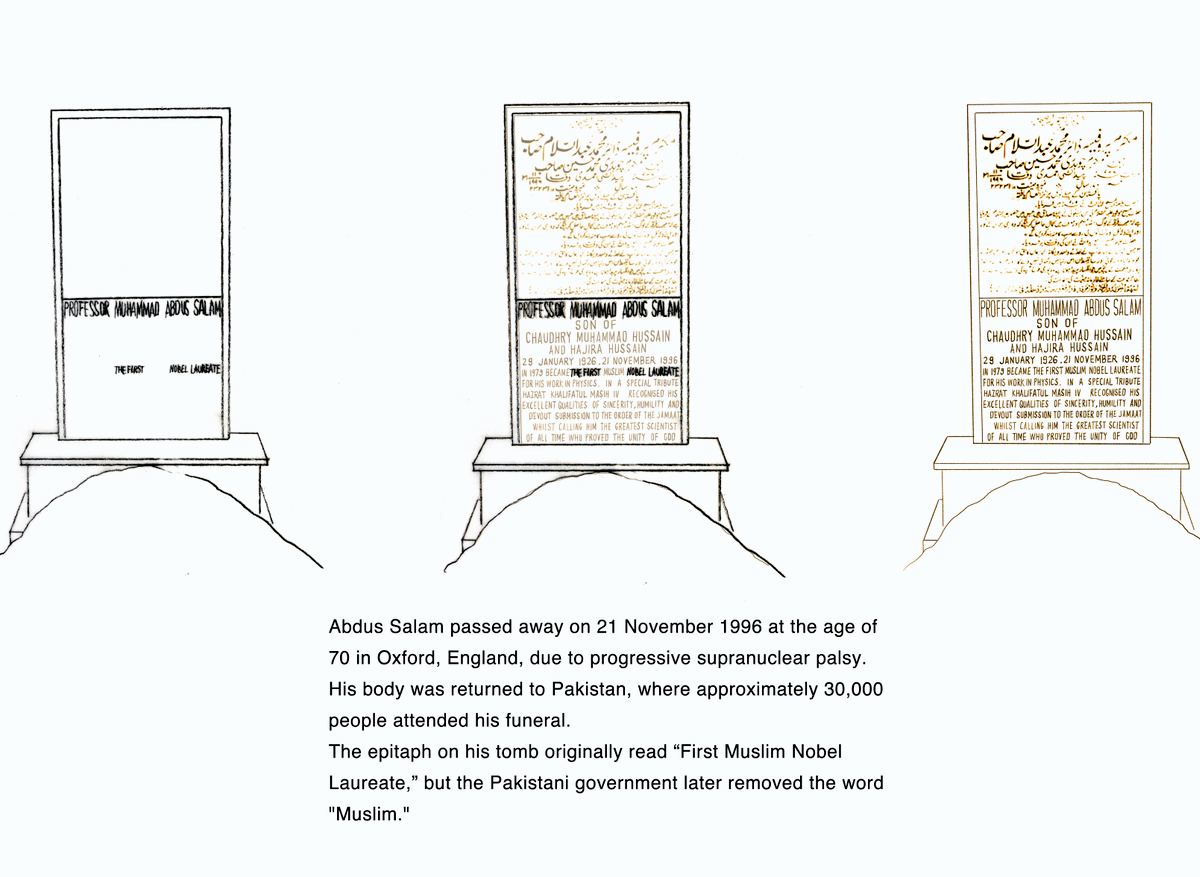
Abdus Salam passed away on 21 November 1996 at the age of 70 in Oxford, England, due to progressive supranuclear palsy. His body was returned to Pakistan, where about 30,000 people attended his funeral. The epitaph on his tomb originally read "First Muslim Nobel Laureate", but the Pakistani government later removed the word "Muslim".
“It became quite clear to me that either I must leave my country or leave physics. And with great anguish, I chose to leave my country.”
Dr Abdus Salam
The first Pakistani to win the Nobel prize
This project explores the life of Abdus Salam, the first Nobel Prize winner from Pakistan and a groundbreaking theoretical physicist. He studied at the University of Cambridge, where he earned his degree and began his scientific journey.
Throughout his life, due to his religious identity and background, yet remained deeply committed to scientific knowledge and his homeland.
I developed this project in collaboration with a Pharmaceutical Science student, Mina, whose grandmother was Salam’s niece. Through her, I gained access to family memories that shaped the emotional core of this work.
The project is also inspired by the documentary Salam: The First ****** Nobel Laureate, which offers a powerful account of his life and legacy.
Identity, Representation, Scientific Legacy, Cultural Heritage, Resilience

Sharon is a Taiwan-born, London-based creative bean specialising in illustration, books, comics, and animations, but most of all, anything about food, people, and mental health. She experiments with vibrant colours, textures, and humour to create a childlike narrative in her work, and she occasionally facilitates cooking classes to bring communities together. She loves dogs, by the way. You can find more of her stuff on Instagram @shushpupps or at her website using the button below.
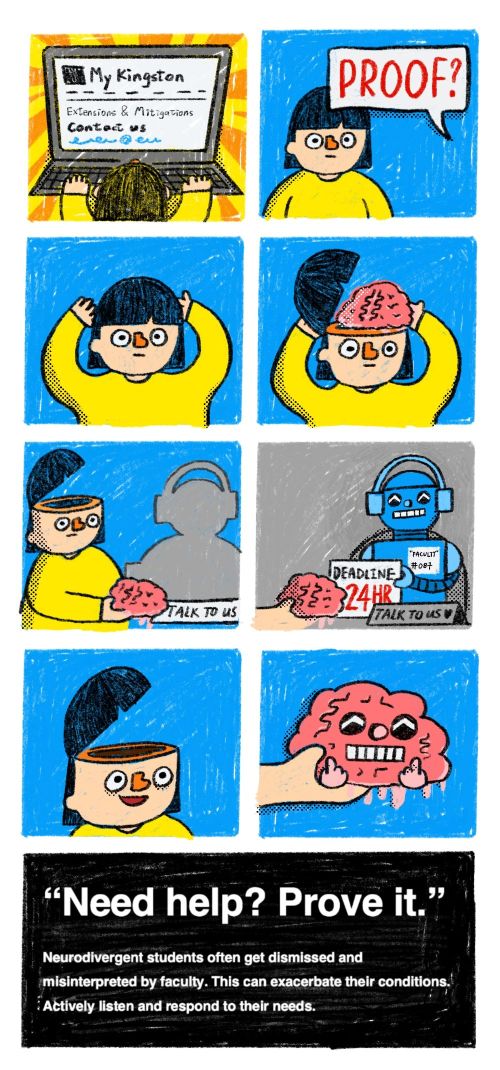
My conversation with Debbie, a chemistry student in Kingston inspired me to think about how school faculty exacerbates discomfort in neurodivergent students when they are unable to understand their conditions and accommodate their needs. The mitigation assessmentsare rather rigid and inhuman, which reminded me of robots.This inspired me to use satirical comics to illustrate the distressing process neurodivergent sudents go through when they try to communicate with school faculty, who have misunderstood and even dismissed their conditions. I hope to address the irony in asking neurodivergent students to "prove" their disadvantages and draw the attention of faculty and staff to this issue
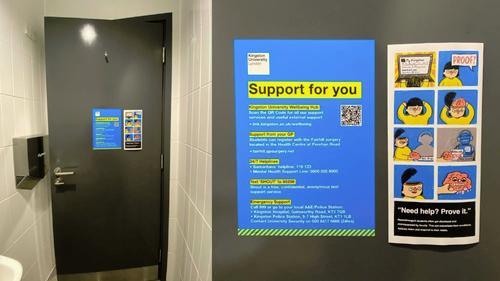
Neurodivergence, Miscommunication, Bureaucracy, Academic Barriers, Satire
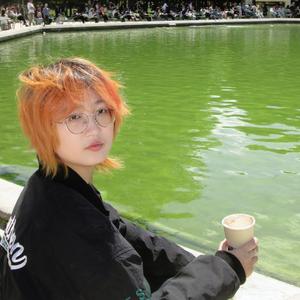
Summer Gao is a creative artist and designer born in mainland China and currently based in London. She holds a Master’s degree in Illustration from Kingston University, with a focus on book design, illustration, and branding. Her work explores themes such as existential philosophy, the history and evolution of office chairs, and child psychology. Summer originally studied forestry in China as an undergraduate. Her interdisciplinary background has fostered a lasting interest in the intersection of art and science.
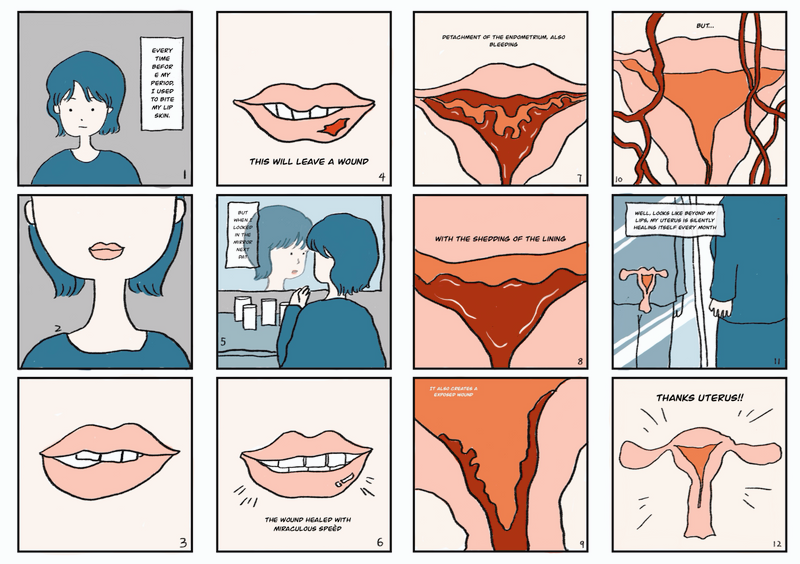
My work uses the process of lip skin quickly repairing to connect the process of shedding and healing of the female uterus during menstruation. A woman's monthly menstrual period will bring about the shedding of the lining of the uterus, which will actually form a hugewound inside the uterus, and the woman's uterus will undergo silent repair and reconstruction every month. I can easily visualize the effort of my external body when I'minjured, but I can't easily see the effort of my internal uterus. The womb silently guards the female body-this is what I want to express in this comic.
The idea came from a discussion my partner and I had about women's menstrual problems. Based on her personal experience, she mentioned that doctors tend to stereotype menstruation-related signs as minor problems only caused by menstruation. However, dueto individual differences, some women with other gynecological symptoms and problems with the uterus may exhibit signs similar to menstruation, which leads to their actual problems being easily overlooked, such as pain caused by endometriosis. Doctors often mistakenly believe that this is just a normal reaction caused by menstruation. This makes me think that even if women menstruate every month, it still doesn't change the fact that the uterus can be ignored because we don't have a direct view of how it functions. In contrast, I can notice it immediately once my lips bleed. That's why I wanted to link them together.
Menstruation, invisible pain , healing, medical bias, female body
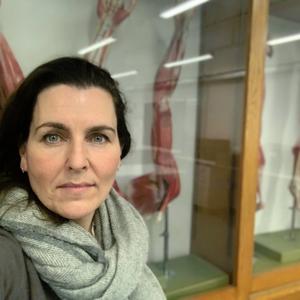
Dr Francesca Arrigoni is an Associate Professor in Physiology and Pharmacology in the Department of Pharmacy at Kingston. Her pioneering transdisciplinary teaching seamlessly integrates art and science, breaking traditional boundaries to enhance public understanding and revolutionise teaching practices in higher education. Her innovative approach not only informs and engages diverse audiences but also fosters creative and critical thinking. Her innovative approaches in nursing education earned her the Teaching Innovation of the Year award in 2023, presented by the Student Nursing Times.
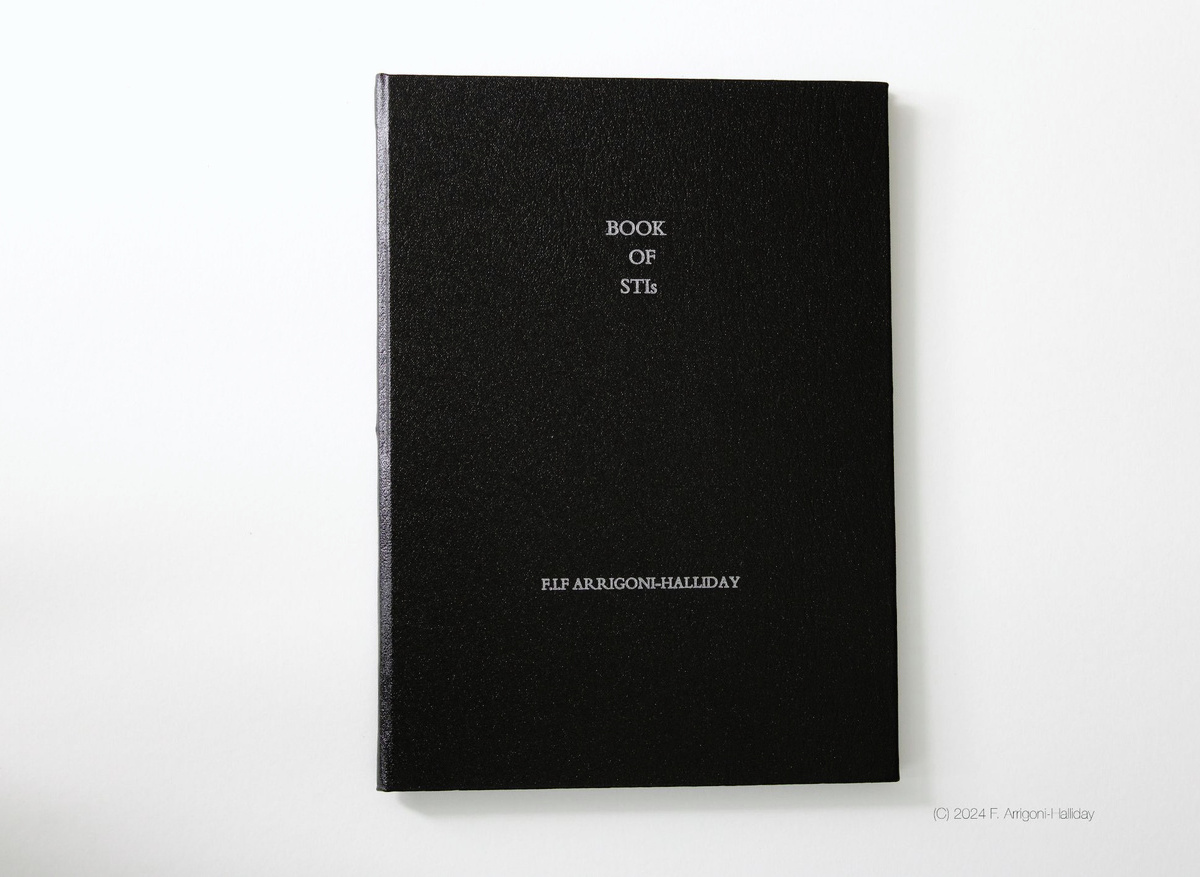
“Book of STIs” F.I.F Arrigoni-Halliday
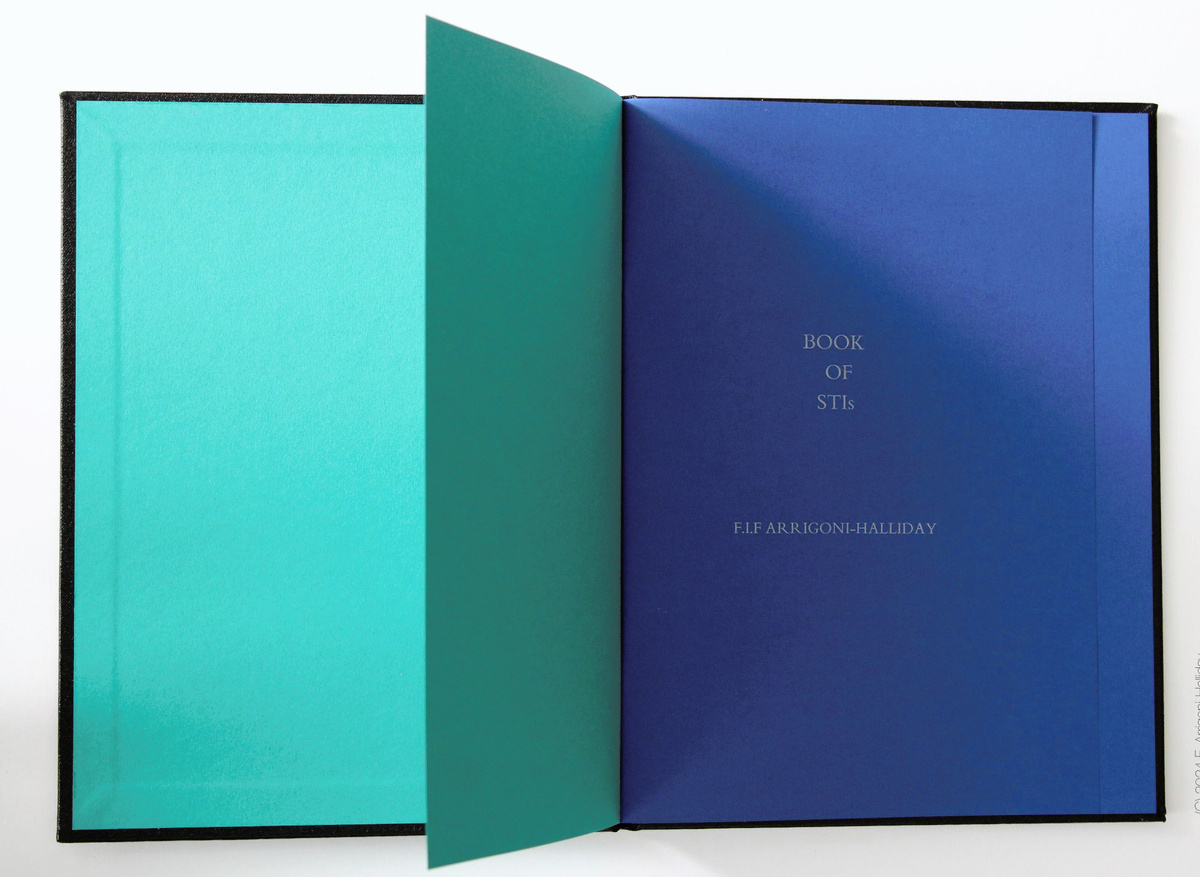
“Book of STIs” F.I.F Arrigoni-Halliday
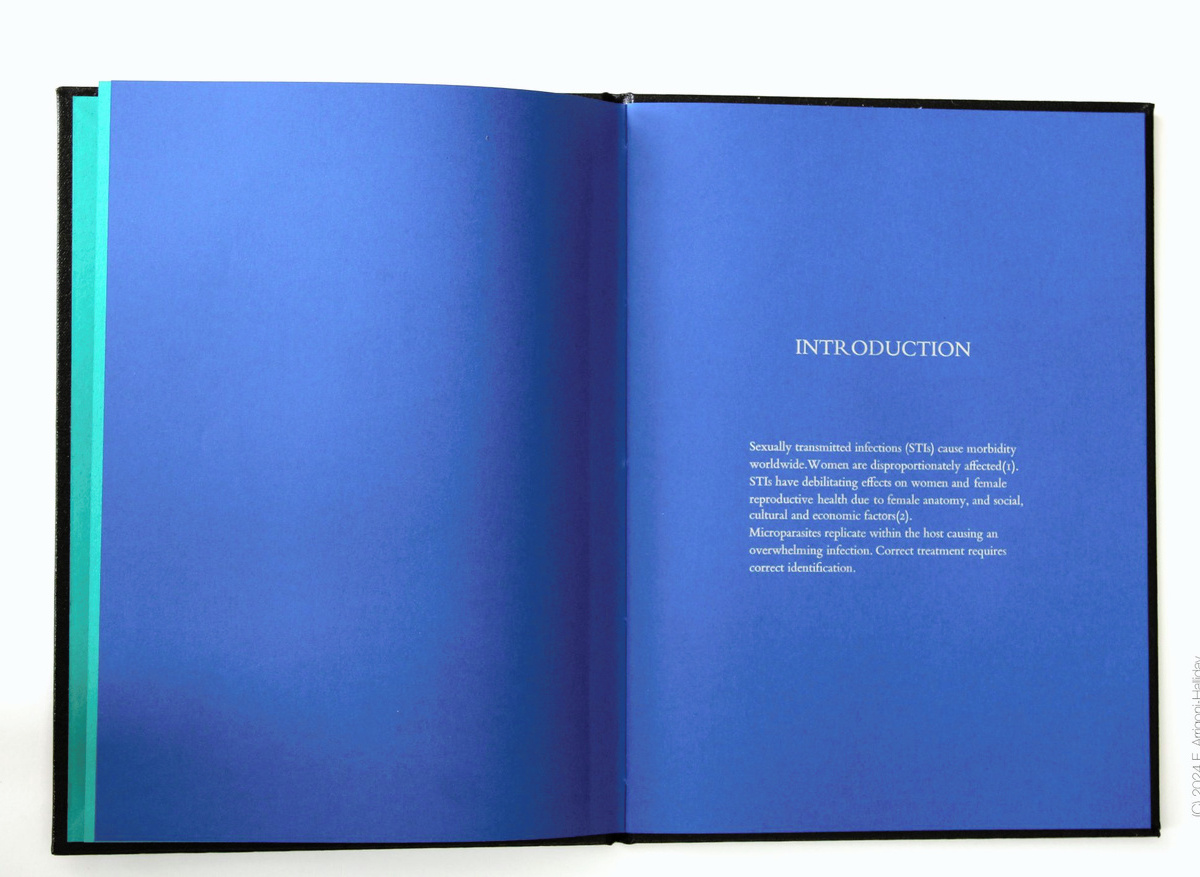
Sexually transmitted infections (STIs) cause morbidity worldwide. Women are disproportionately affected (1). STIs have debilitating effects on women and female reproductive health due to female anatomy, and social, cultural and economic factors(2). Microparasites replicate within the host causing an overwhelming infection. Correct treatment requires correct identification.
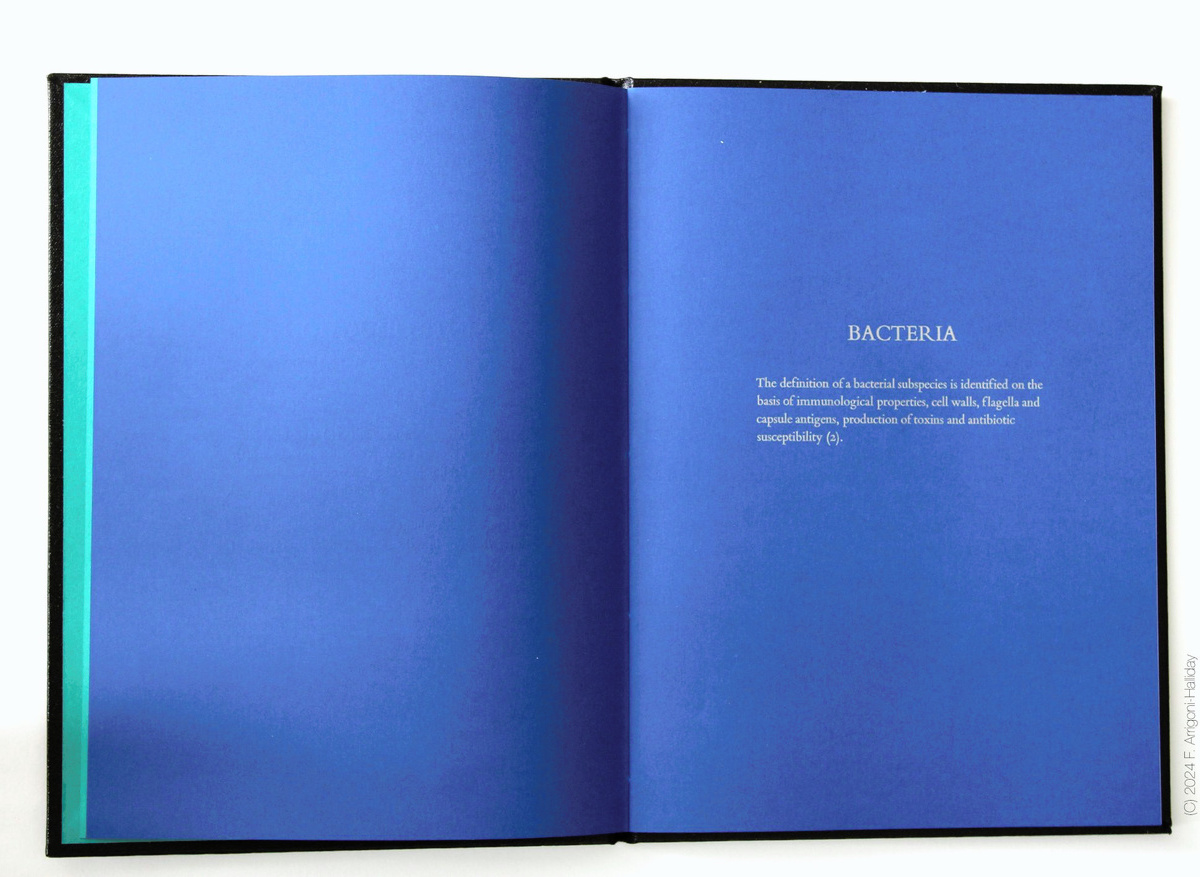
The definition of a bacterial subspecies is identified on the basis of immunological properties, cell walls, flagella, and capsule antigens, production of toxins and antibiotic susceptibility (2).
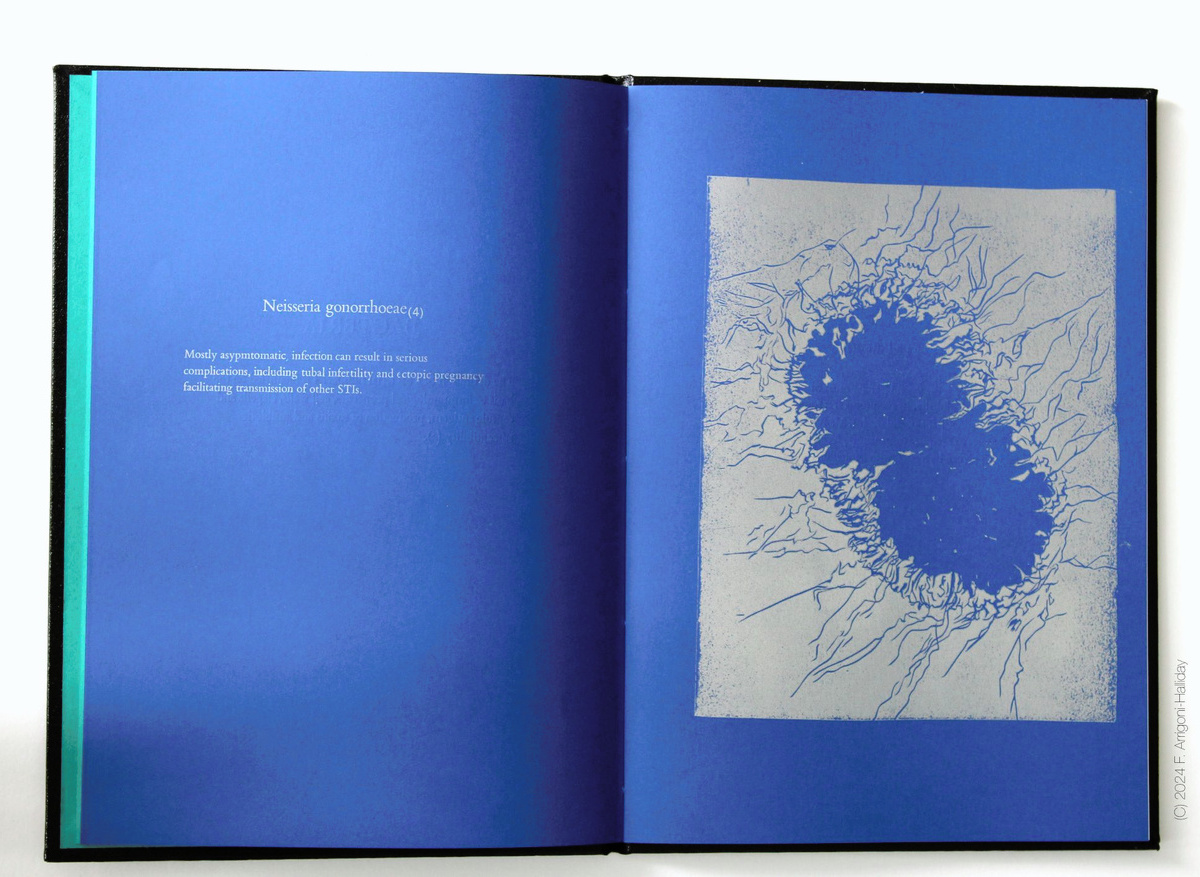
Mostly asymptomatic, infection can restul in serious complications, including tubal infertility and ectopic pregnancy facilitating transmission of other STIs.
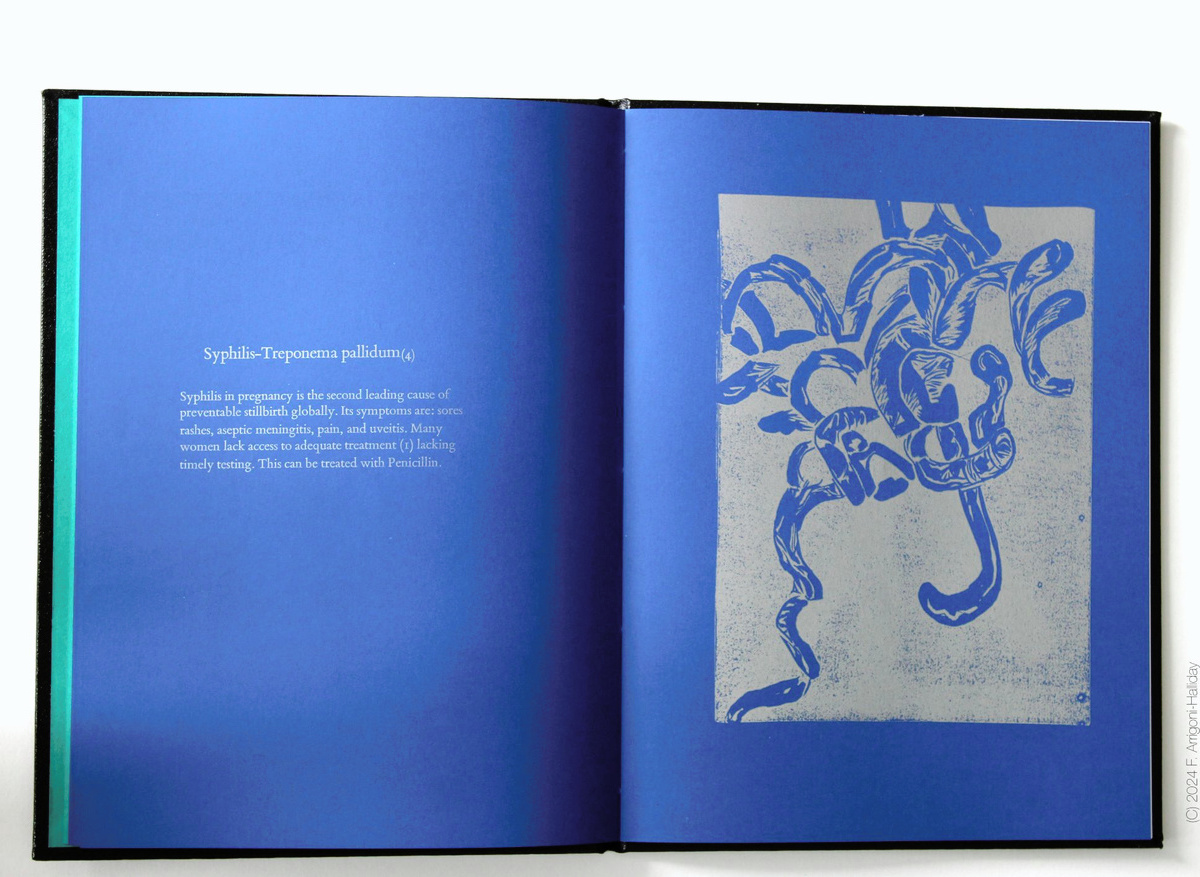
Syphilis in pregnancy is the second leading cause of preventable stillbirth globally. Its symptoms are: sores, rashes, aseptic meningitis, pain, and uveitis. Many women lack access to adequate treatment (1) lacking timely testing. This can be treated with Penicillin.

This can only replicate inside a host cell and causes reproductive damage, ectopic pregnancies, pain and tubal infertility. It affects hundreds of millios of people globally and is the most common cause of preventable blindness(1). It can be treated with antibiotics.
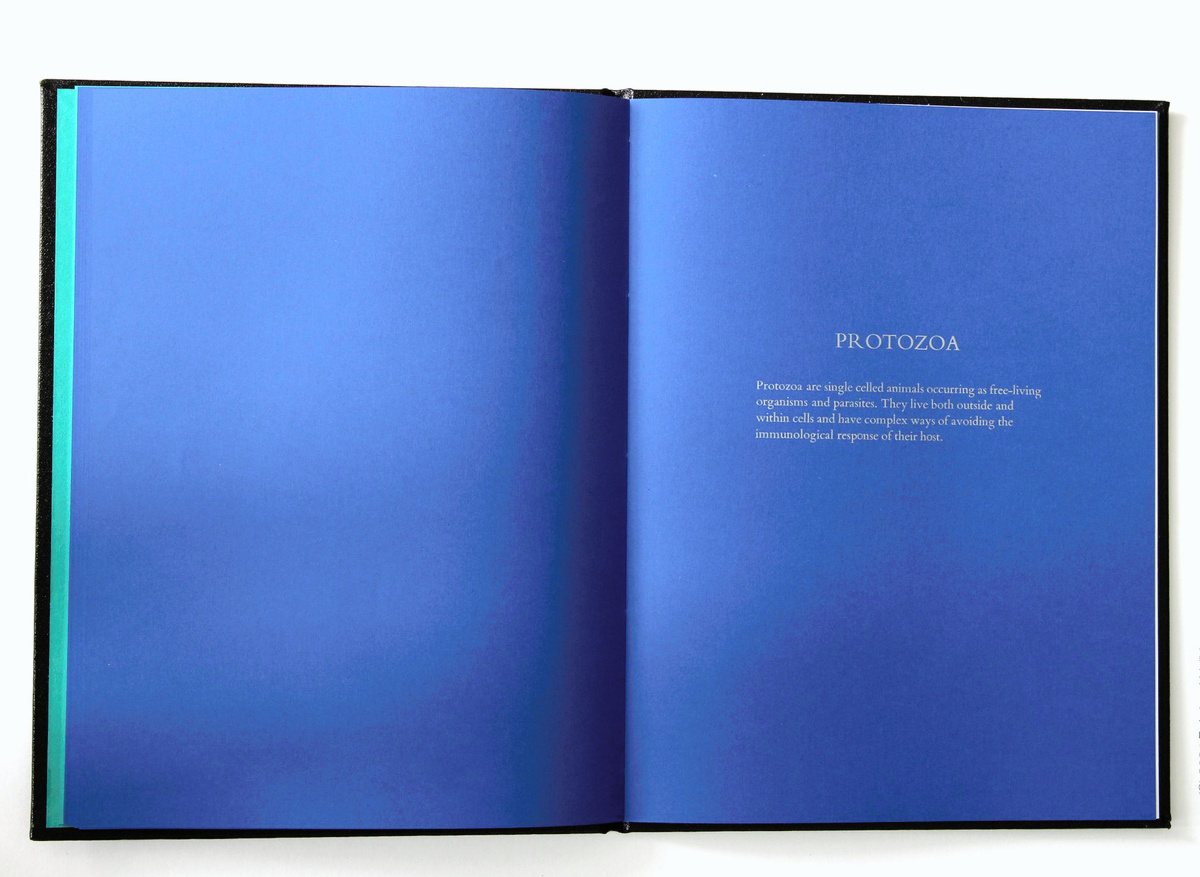
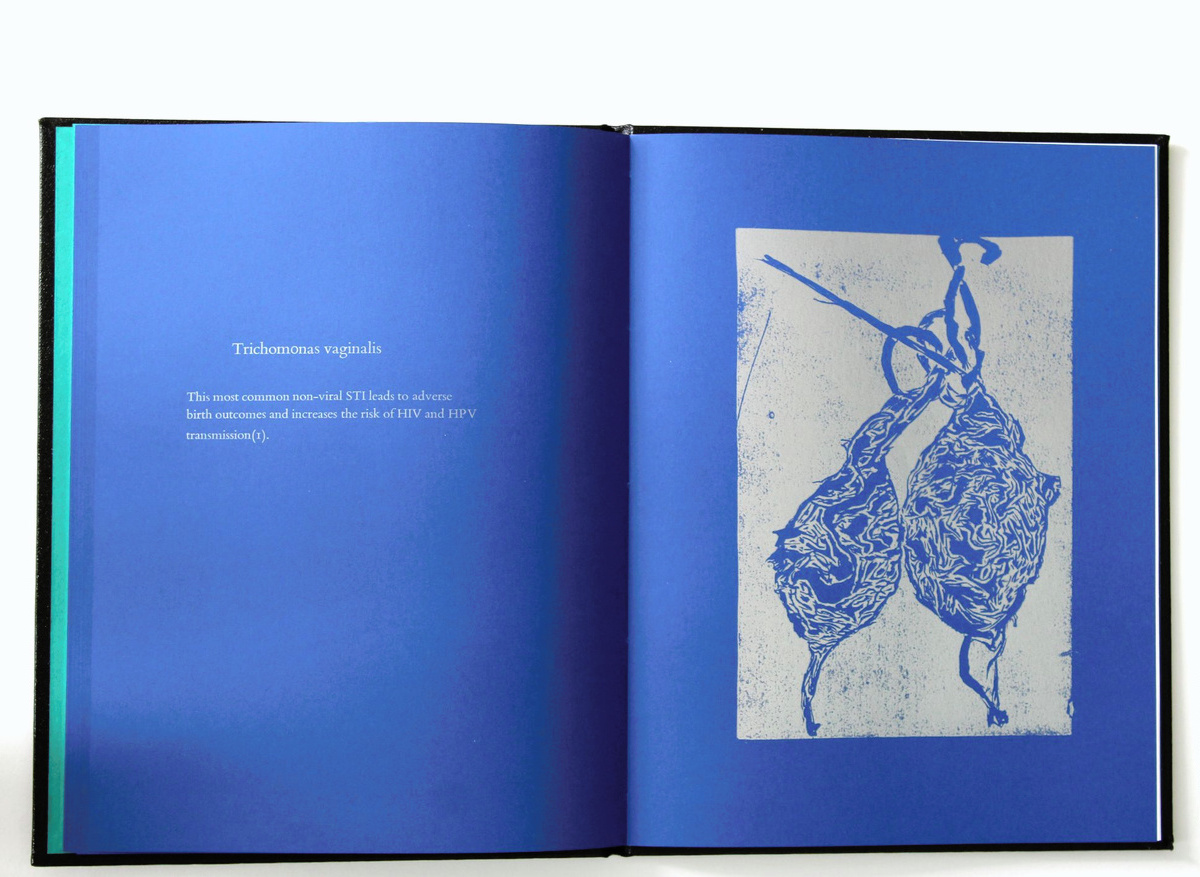
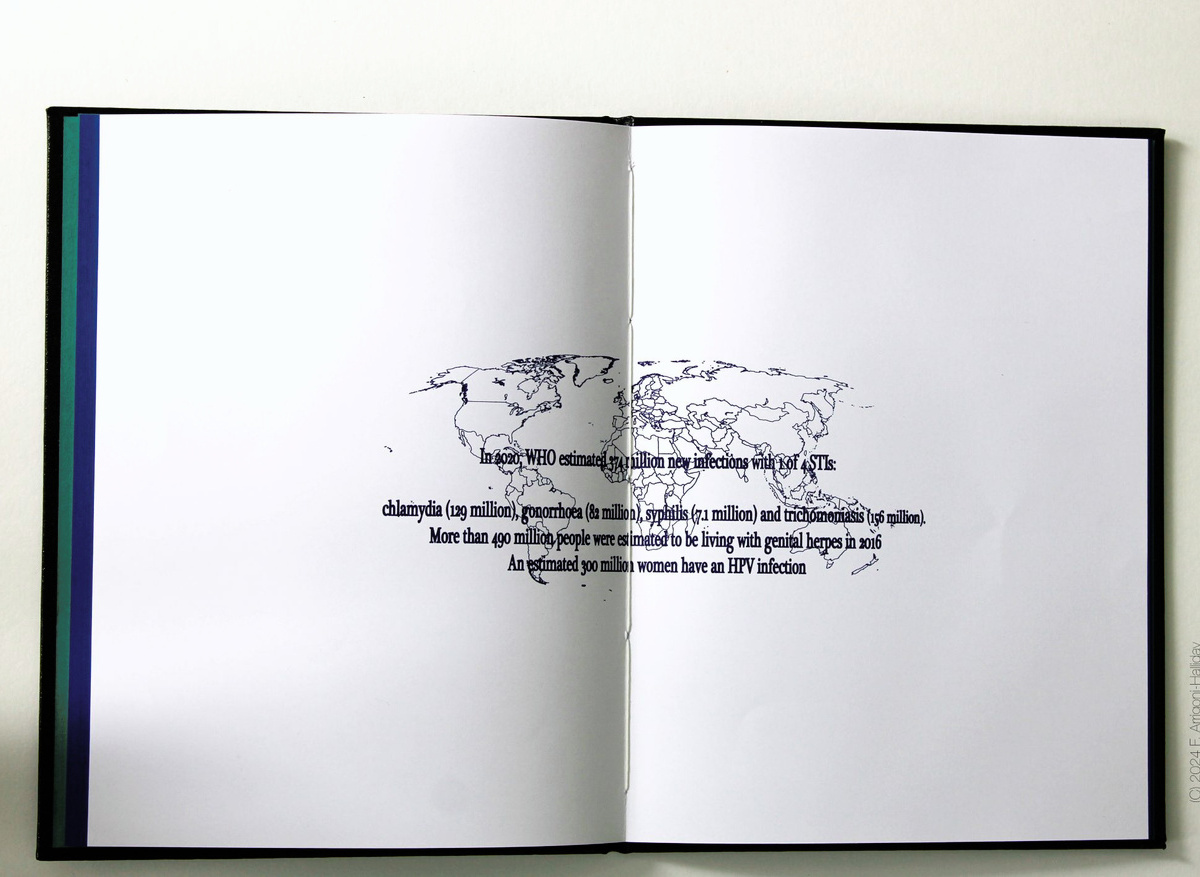
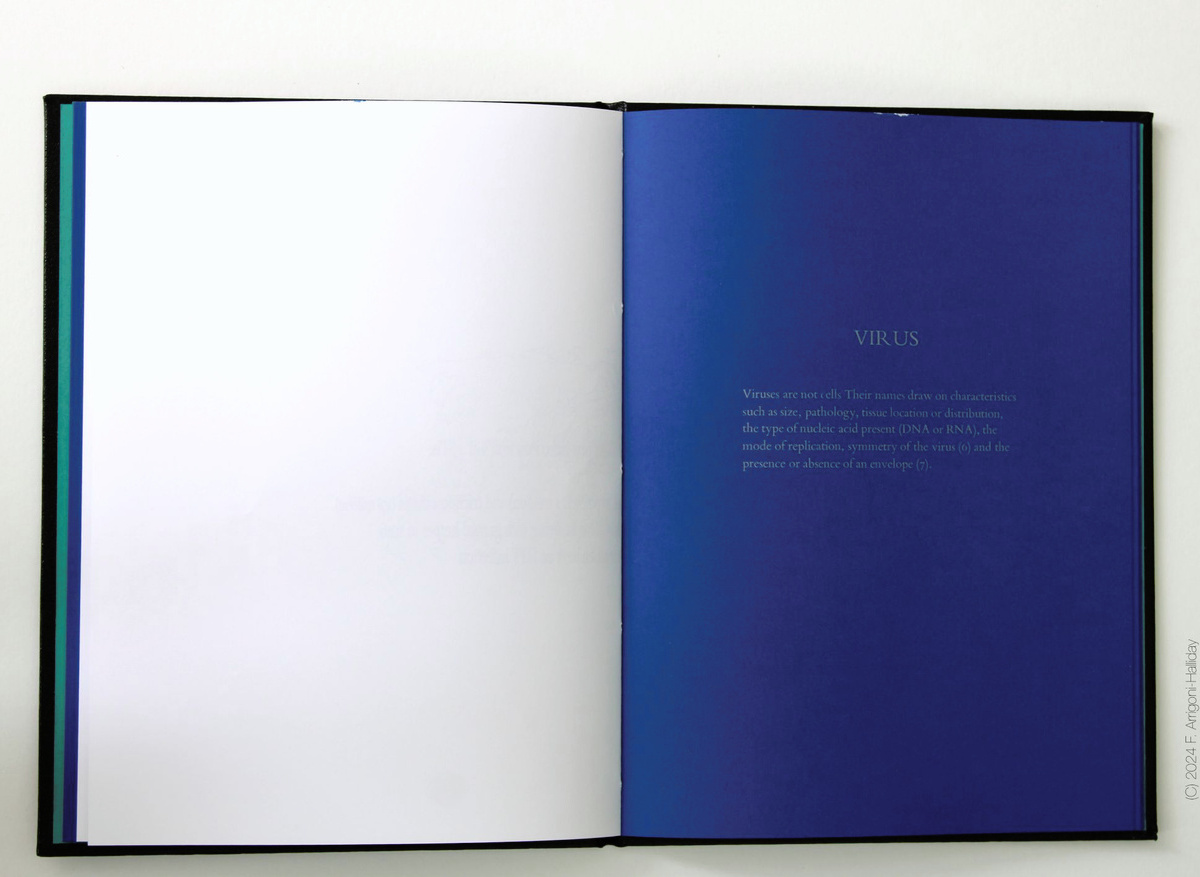
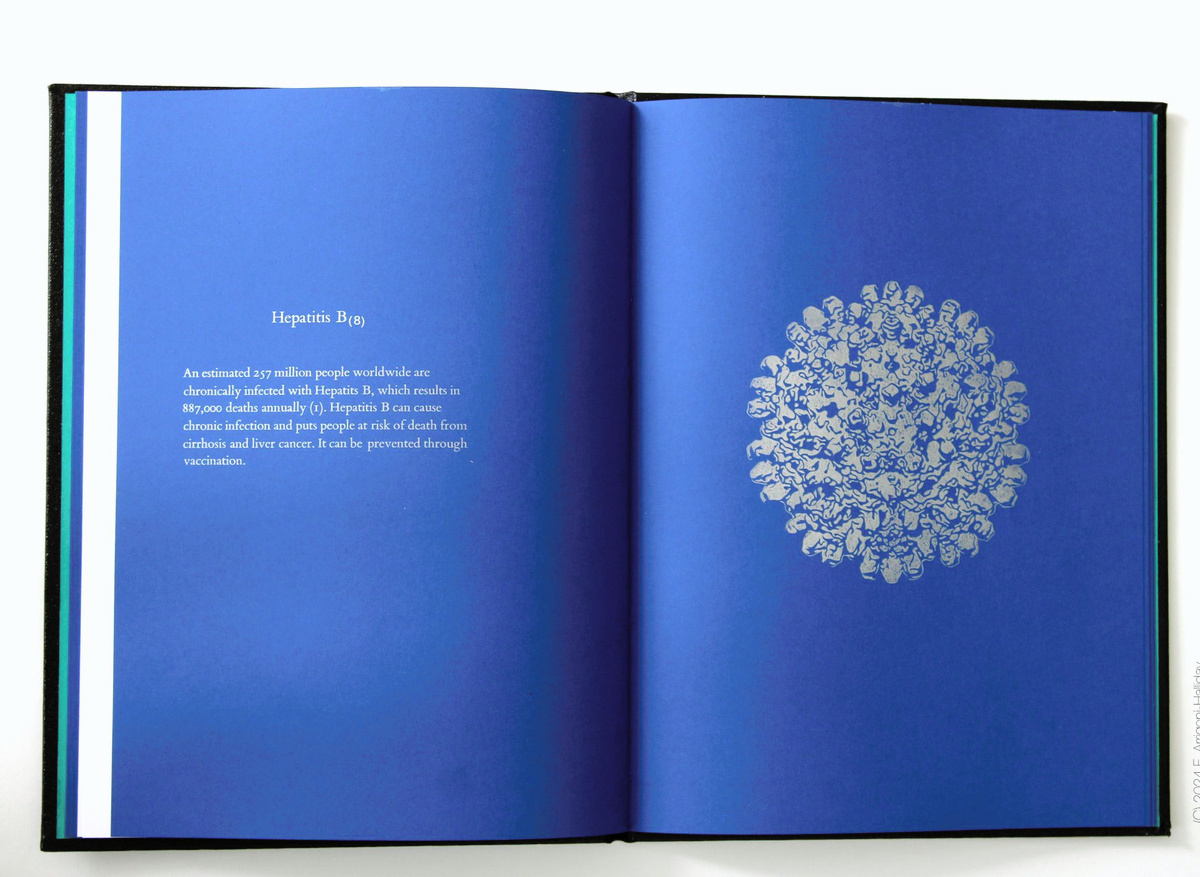
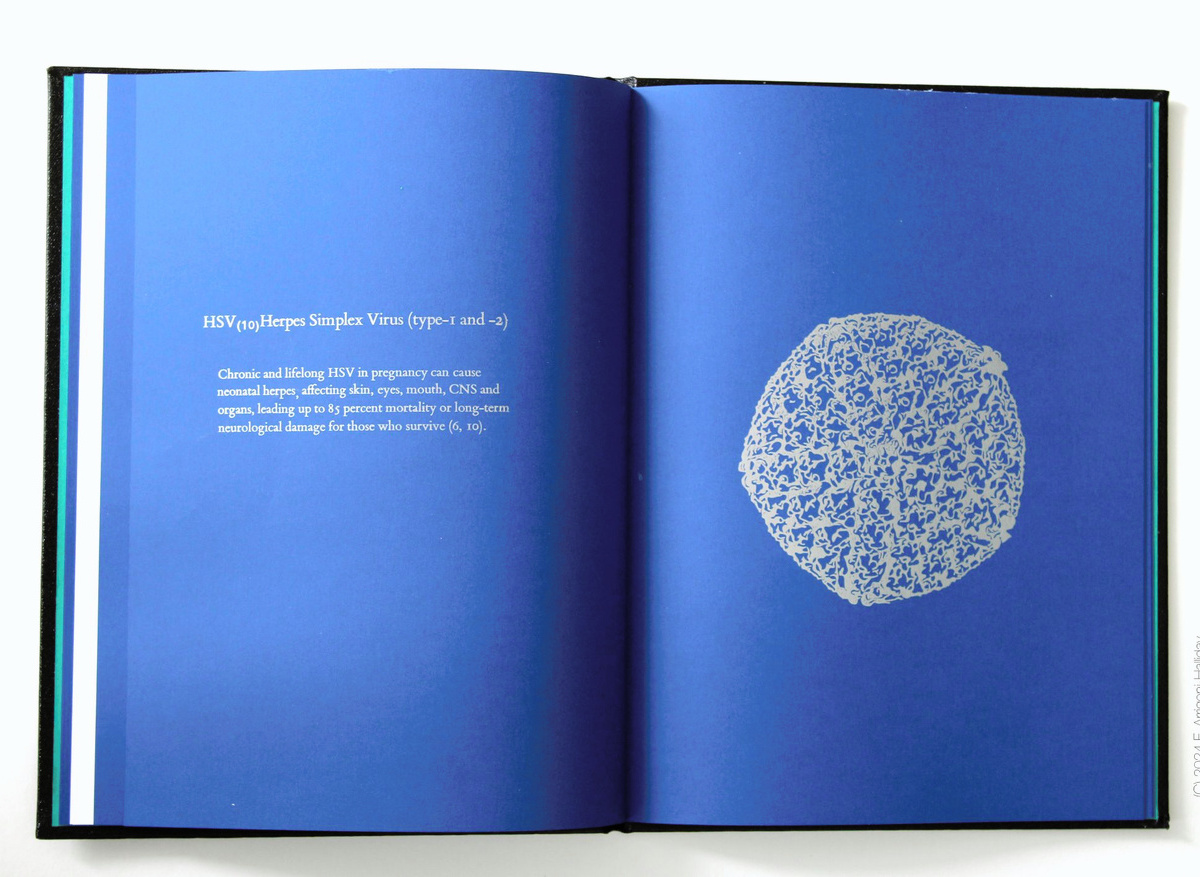

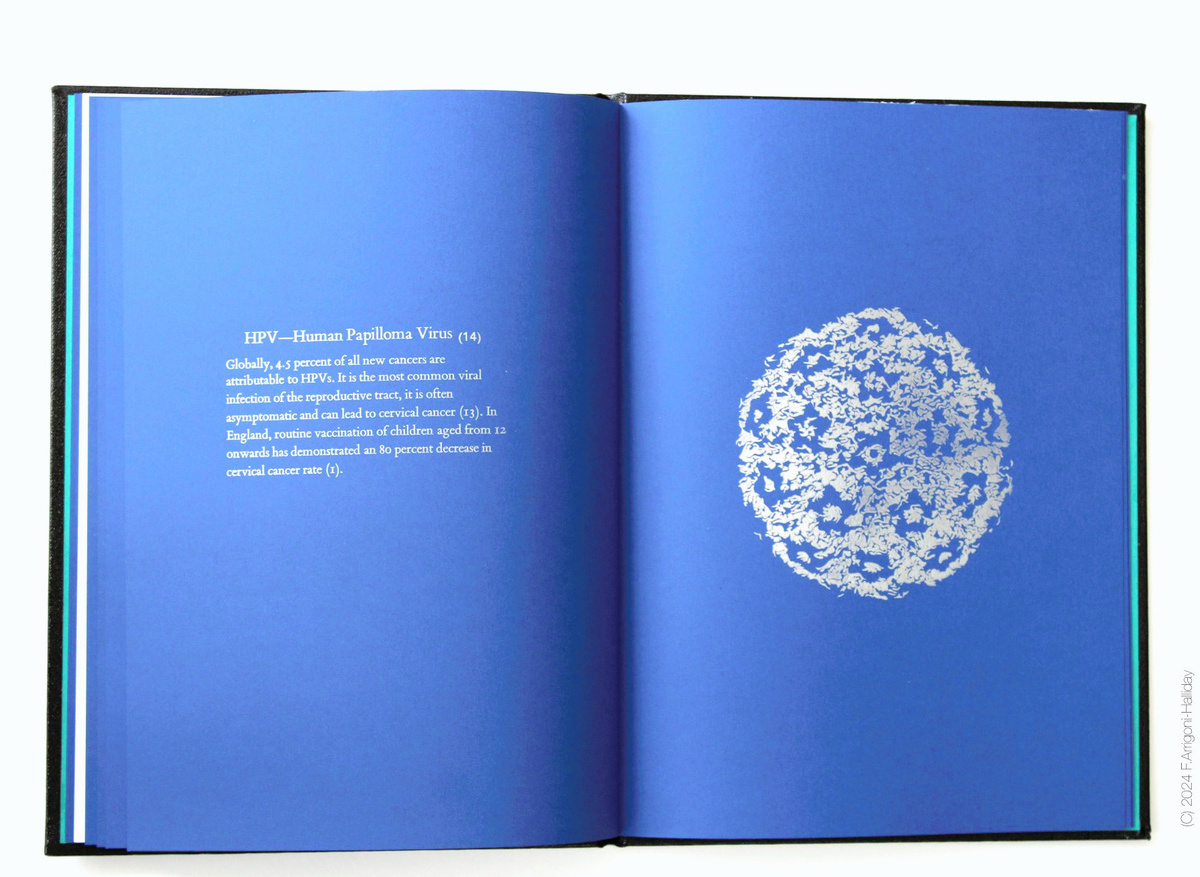

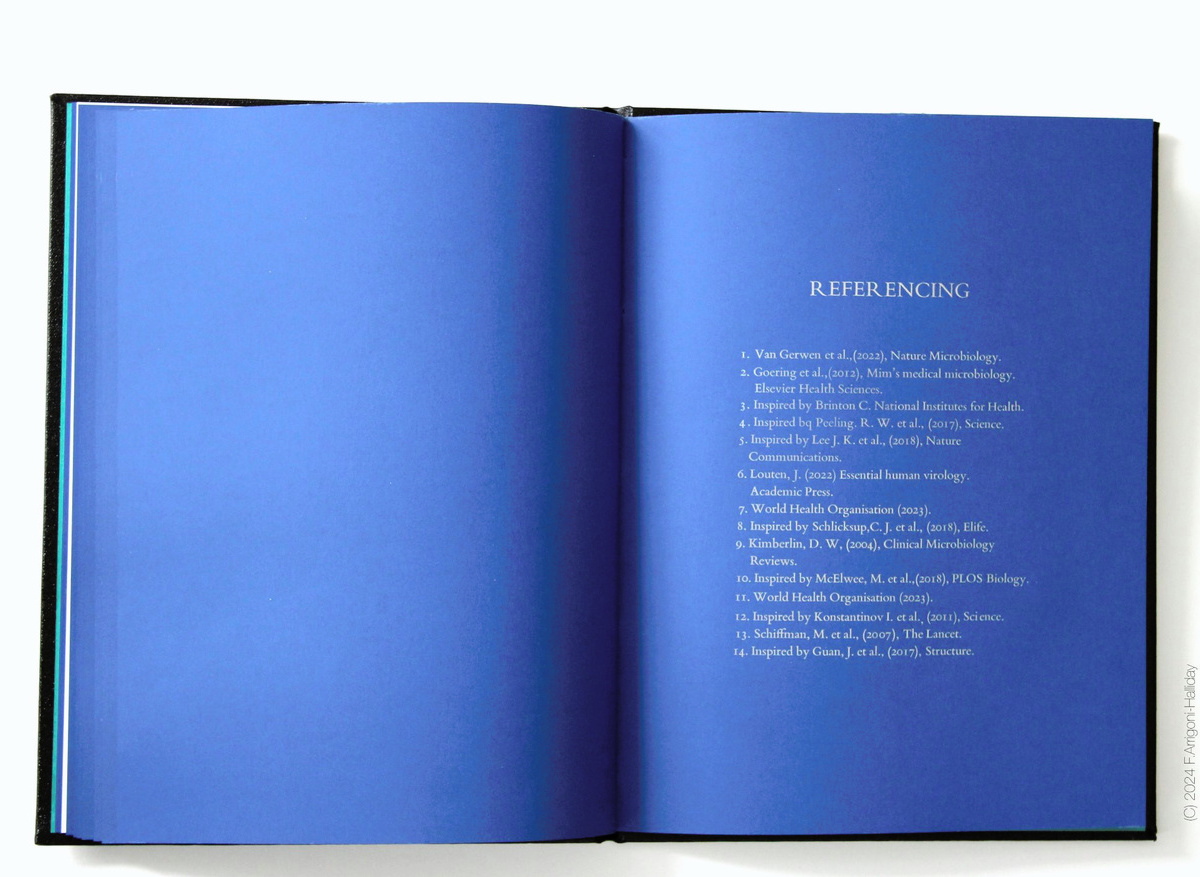
The Book of STIs,” inspired by visits to the Hunterian Museum, London, explores the aesthetic beauty of the infections, and whilst highlighting medical advances, reveals how marginalized individuals, particularly women, still face these threats. I used Letterpress printing, which has historically fostered intellectual and cultural revolutions, as a means of advocacy that has challenged the status quo and promoted social change. To ensure accessibility to a broad readership, the book adopted a juxtaposition, presenting both an aesthetic appeal in contrast to the inherent horror of the disease. This not only engages readers visually but also underscores the gravity of the subject matter through a harmonious blend of beauty and stark reality.
The themes exposed in “The Book of STIs” are rich and multifaceted, blending art, medicine, and social commentary.
Medical Aesthetics, Stigma & Inequality, Public Health Advocacy, Feminist Critique, Art as Activism
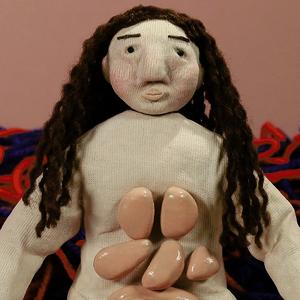
Ann Man Hei Wong is a visual storyteller working across stop motion animation, illustration, installations, zines, and comics. Her analogue, three-dimensional approach to image-making explores themes of urban life, the human body, wellbeing, and displacement.
Inspired by a kyphoscoliosis-afflicted skeleton and my own experience with scoliosis, Curves is a stop motion animation that reimagines the specimen as a tranquil tree in nature. Through vivid colours and natural soundscapes, the animation seeks to transform viewers' perceptions of the diseased human body, revealing beauty and elegance in a curved spine by juxtaposing it with the organic curves and asymmetrical forms found in the natural world.
Body, Nature & Form, Disability Perceptions, Transformative, Anatomy Art